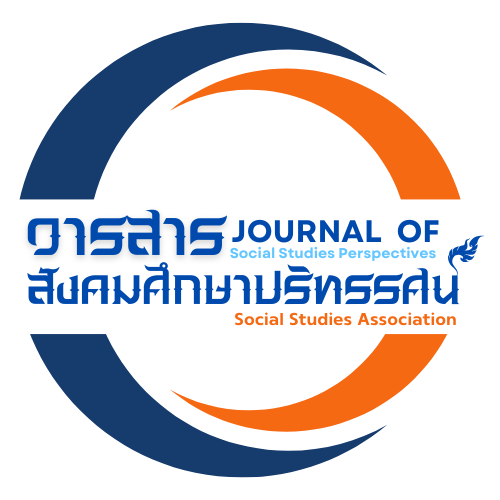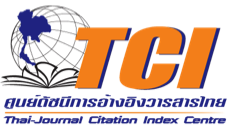การพัฒนารูปแบบการจัดการศึกษาที่ยืดหยุ่นเพื่อป้องกันการหลุดออกจากระบบ ของนักเรียนกลุ่มเสี่ยง : กรณีศึกษาโมเดล 5D โรงเรียนบ้านนาโก
DOI:
https://doi.org/10.64186/jsp2568คำสำคัญ:
การจัดการศึกษาที่ยืดหยุ่น , โมเดล 5D , นักเรียนกลุ่มเสี่ย, การป้องกันการหลุดออกจากระบบบทคัดย่อ
บทความวิจัยนี้มีวัตถุประสงค์เพื่อ 1) พัฒนารูปแบบการจัดการศึกษาที่ยืดหยุ่น 5D เพื่อช่วยเหลือนักเรียนกลุ่มเสี่ยงหลุดออกจากระบบการศึกษา และ 2) ศึกษาผลการใช้รูปแบบดังกล่าวในบริบทโรงเรียนขยายโอกาสในพื้นที่ชนบท การวิจัยนี้เป็นการวิจัยและพัฒนา (Research and Development) กลุ่มเป้าหมายคือนักเรียนกลุ่มเสี่ยงต่อการหลุดออกจากระบบการศึกษาโรงเรียนบ้านนาโก จังหวัดเลย ซึ่งการได้มาซึ่งกลุ่มตัวอย่างเป็นการคัดเลือกแบบเจาะจง เครื่องมือที่ใช้ในการพัฒนานวัตกรรมคือกระบวนการ 5 ขั้นตอนของโมเดล 5D (Discover, Design, Do, Discuss, Develop) และเครื่องมือรวบรวมข้อมูล ได้แก่ แบบสังเกตพฤติกรรม แบบสัมภาษณ์เชิงลึก และแนวคำถามสำหรับการประชุมสะท้อนผล การวิเคราะห์ข้อมูลใช้การวิเคราะห์เนื้อหาและนำเสนอเชิงพรรณนา ผลการวิจัยพบว่า รูปแบบการจัดการศึกษาที่ยืดหยุ่น 5D ประกอบด้วย 5 ขั้นตอนสำคัญ คือ 1) การค้นหาตัวตนและศักยภาพ (Discover) 2) การร่วมออกแบบเส้นทางการเรียนรู้เฉพาะบุคคล (Design) 3) การลงมือปฏิบัติผ่านกิจกรรมและโครงงานฐานชีวิตจริง (Do) 4) การตรวจสอบและสะท้อนผลร่วมกัน (Discuss) และ 5) การพัฒนาและต่อยอดสู่โอกาสใหม่ (Develop) ผลการใช้รูปแบบซึ่งประเมินจากการวิเคราะห์ข้อมูลเชิงคุณภาพผ่านแบบสังเกตพฤติกรรมและการสัมภาษณ์ พบว่า นักเรียนกลุ่มเสี่ยงมีแรงจูงใจในการเรียนรู้เพิ่มขึ้น มีความผูกพันกับโรงเรียนมากขึ้น และ อัตราการเสี่ยงหลุดออกจากระบบลดลงอย่างเห็นได้ชัด
เอกสารอ้างอิง
Association for Supervision and Curriculum Development. (2012). The whole child approach. Association for Supervision and Curriculum Development.
Blair, D. (2011). Intrinsic motivation and engagement as active ingredients in garden-based education: Examining models and measures derived from self-determination theory. The Journal of Environmental Education, 42(3), 197–199. https://doi.org/10.1080/00958964.2010.540194
Chaleerat, M. (2023). The effectiveness of a personalized learning program on increasing learning motivation among at-risk youth. Chulalongkorn Journal of Education, 51(2), 45–60.*
Deci, E. L., & Ryan, R. M. (1985). Intrinsic motivation and self-determination in human behavior. Plenum.
Epstein, J. L. (2018). School, family, and community partnerships: Preparing educators and improving schools (2nd ed.). Routledge.
Equitable Education Fund. (2023). Educational inequality situation in 2023. https://www.eef.or.th/publication/inequality-report-2023/
Equitable Education Fund. (2024). Summary report on reducing inequality through building collaborative partnerships. Office of the Equitable Education Fund.
Institute of Education Sciences. (2008). Dropout prevention (NCEE 2008-4025). U.S. Department of Education. https://ies.ed.gov/ncee/wwc/PracticeGuide/9
Johnston, J. H. (2010). Dropout prevention: An EPI research brief. Education Partnerships, Inc.
Kolb, D. A. (1984). Experiential learning: Experience as the source of learning and development. Prentice-Hall.
Maslow, A. H. (1943). A theory of human motivation. Psychological Review, 50(4), 370–396. https://doi.org/10.1037/h0054346
Ministry of Education. (2022). Unlock, adjust, open up: Powering up education towards excellence. Ministry of Education. https://moe360.blog/2020/09/08/
National Economic and Social Development Council. (2023). Thai social outlook: Q4 and annual report 2023. https://www.nesdc.go.th/main.php?filename=social_outlook
Piaget, J. (1972). The psychology of the child. Basic Books.
Santhanu, P. (2024). Developing vocational skills and student retention through project-based learning in community contexts: A case study of an opportunity expansion school. Journal of Education, Naresuan University, 26(1), 112–125.*
Wilson, S. J., & Tanner-Smith, E. E. (2013). Dropout prevention and intervention programs for improving school completion among school-aged children and youth: A systematic review. Journal of the Society for Social Work and Research, 4(4), 357–372. https://doi.org/10.1086/673235
ดาวน์โหลด
เผยแพร่แล้ว
รูปแบบการอ้างอิง
ฉบับ
ประเภทบทความ
หมวดหมู่
สัญญาอนุญาต
ลิขสิทธิ์ (c) 2025 วารสารสังคมศึกษาปริทรรศน์

อนุญาตภายใต้เงื่อนไข Creative Commons Attribution-NonCommercial-NoDerivatives 4.0 International License.
บทความนี้ได้รับการเผยแพร่ภายใต้สัญญาอนุญาต Creative Commons Attribution-NonCommercial-NoDerivatives 4.0 International (CC BY-NC-ND 4.0) ซึ่งอนุญาตให้ผู้อื่นสามารถแชร์บทความได้โดยให้เครดิตผู้เขียนและห้ามนำไปใช้เพื่อการค้าหรือดัดแปลง หากต้องการใช้งานซ้ำในลักษณะอื่น ๆ หรือการเผยแพร่ซ้ำ จำเป็นต้องได้รับอนุญาตจากวารสาร










